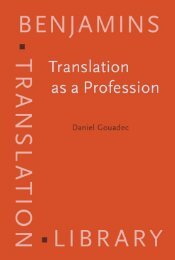Constructing a Sociology of Translation.pdf
Constructing a Sociology of Translation.pdf
Constructing a Sociology of Translation.pdf
- No tags were found...
Create successful ePaper yourself
Turn your PDF publications into a flip-book with our unique Google optimized e-Paper software.
17 Andrew Chestermancontributory conditions, however, some may stand out as seeming more influentialthan others. In von Wright’s terms (2004/1971: 85), we could say that translationresearch can provide “quasi-causal” explanations. Quasi-causes are notnomic (i.e. not based on a lawlike regularity), but they can explain why a givenevent was possible, and they can make it easier to understand why the event (or,say, textual feature) occurred. They can reduce our surprise; the event then seemsto “make sense”.It is <strong>of</strong>ten observed, moreover, that all external causes <strong>of</strong> translations, or particularfeatures in translations, only exert a causal force by virtue <strong>of</strong> their beingchannelled or filtered through the translator’s mind. Cultural and sociologicalpressures and values, norms and instructions, only have an effect on the targettext via the individual translator’s cognition, since the text itself is only producedby the translator’s agency (see further Chesterman 2002). On the theoretical level,this is visible in the criticism directed against polysystem theory, viz. that its concepts(system, polysystem) are too abstract to be able to function as real causes(Pym 1998: Chapter 7; Hermans 1999: Chapter 11). If translation sociology placespeople centre-stage, and uses a causal model, it can also highlight genuine humanagency and give space to the translator’s subjectivity.Practice, discourse and habitusWhat other bridges are available between these four different perspectives? Traditionally,we have been accustomed to seeing the textual perspective as centraland primary, with the other perspectives more relevant to establishing the backgroundconditions and consequences <strong>of</strong> the texts themselves. Indeed, this is theway I framed the causal model above. But what questions arise once the socialperspective is placed at the centre? This means starting with a focus on people andwhat they do. If we take this viewpoint, three bridge concepts can be highlightedwhich help us to conceptualize connections between the social perspective andthe other three.One concept that covers both social and cultural aspects is that <strong>of</strong> the translationpractice, understood as the set <strong>of</strong> translation events within a given temporal,institutional and cultural setting, influenced by and itself affecting cultural valuesand traditions. Between the social and the textual we have discourse, linking textsto their communicative context <strong>of</strong> production and reception. Discourse is a notoriouslyslippery term. I am not using it here in its narrow linguistic sense <strong>of</strong> “languagebeyond the sentence”. Rather, I refer to the sense “language use in context”(see e.g. Brown and Yule 1983), and also more generally to the way in which theterm is used to designate the wider context <strong>of</strong> a social practice (see e.g. Fairclough
















